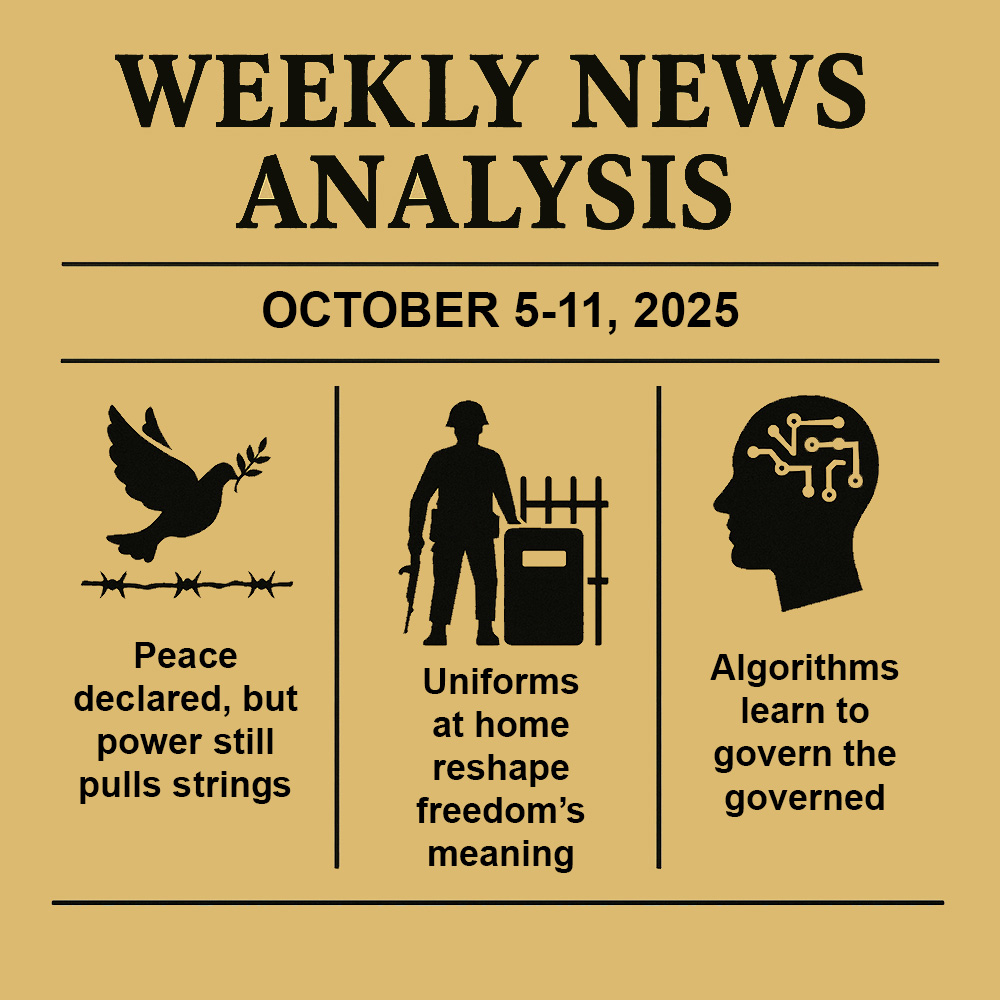
Trump’s self-congratulation over the Gaza ceasefire played out as most “historic” Middle East events do: as spectacle first, substance second. This week also saw uniformed troops deployed onto American streets—again—under the banner of “protecting” federal sites in defiant blue cities. Lastly, this week saw the quiet merging of AI firms and the security state, with governors training civil servants to use models while Washington considers broader national-security exceptions. Across all three events, the message remains the same: emergency framing, moral outsourcing to “process,” and an ever-expanding perimeter of acceptable state authority.
The language is familiar. Announce a deal, flood the zone with victory rhetoric, and keep the details—the timelines, the enforcement, the exit strategies—within footnotes. Present deployments as “temporary” and “protective,” rather than domestic militarization. Introduce AI pilots as “literacy” initiatives and “workforce upskilling,” while federal agencies and vendors develop exception regimes for classified tasks. The logic is that of managed permanence: crisis as an operating system. The rhetoric is a form of moral anesthesia: peace through press conferences, safety through staging, progress through procurement.
Brokered Peace or Stagecraft
Israel and Hamas sign Gaza ceasefire and hostage deal - Reuters
Live: Israel–Hamas ceasefire updates – New York Times
Hamas accepts Trump peace plan - Fox News
Hamas ceasefire: historical background – Washington Institute
Brief history of Israel–Hamas ceasefires – Israel Policy Forum
Trump’s claim to have “brokered” peace puts a personal stamp on a multilateral, mediator-heavy process involving Egypt, Qatar, and others, as well as a familiar hostage-for-prisoners framework. Reuters confirms cabinet ratification, timelines (ceasefire +72-hour hostage window), and partial IDF withdrawal—yet highlights unresolved core issues: Hamas disarmament and Gaza governance, which are often the parts that unravel “historic” deals. The framing credits a single statesman, but the structure remains a layered bargain with many veto players. This asymmetry—headline credit versus back-page caveats—is classic political theater.
The historical record advises caution. As the Washington Institute and Israel Policy Forum detail, ceasefires between Israel and Hamas occur as cyclical truces—nine declared or offered since the Oslo Accords, with outside mediators, short lulls, and re-escalations. The pattern is: “lull,” provocation, retaliatory cycles, then another superficial pause. When rhetoric claims “end of war,” logic questions: what’s different this time in enforcement, incentives, and third-party guarantees? Without stable governance structures, ceasefires act as pauses, not solutions.
Meanwhile, the U.S. keeps the material link intact. Independent estimates suggest that at least $21.7 billion in U.S. military aid has been provided to Israel since October 7, 2023, with more contracted for future delivery—hardly the language of de-escalation. Such aid flows sit uncomfortably alongside peace-broker rhetoric because they indicate the capacity for continued coercion even as speeches promise restraint. The coherence of aid—its aims, methods, and resources—remains unaddressed in triumphal press briefings.
Then there’s the uncomfortable question of origins. Several accounts—some from Israeli officials—describe early-1980s Israeli support for Islamist social networks in Gaza (pre-Hamas Mujama al-Islamiya) as a way to counter the PLO; later, from 2018 onward, Israel approved or facilitated Qatari cash entering Gaza, publicly described as “humanitarian” or “buying quiet.” Israel denies “funding Hamas,” but the strategic logic—stabilizing the enclave and dividing Palestinian politics—is well documented in mainstream reports and Israeli commentary. Money is flexible: funds that ease budgets can also be diverted to other purposes. The outcome is blowback risk masked as short-term “quiet.”
Seen through the Trivium perspective, the rhetoric of “we ended it” conceals hidden assumptions: that violence can be triggered by press releases; that governance can be postponed to a later “phase”; and that the same actors who armed, approved, or “managed” the adversary can now act as impartial referees of peace without conflicts of interest. Historically, states have even fabricated false-flag justifications to extend their power—Operation Northwoods’ declassified memo is a classic example of this in the U.S.—so claims of victimhood must be examined alongside policy histories that fostered the very threats being cited. The pattern—aid, indulgence, escalation, then “peace”—appears less like a genuine solution and more like a show of control.
Finally, regarding grammar versus governance: The deal's text (hostages, withdrawal corridors) is clear, but the ultimate goal (who rules Gaza, with what police powers) remains vague. Accuracy is used where cameras require it, ambiguity where real power lies. Unless structural incentives change—such as aid conditionality, third-party enforcement, and ending the instrumentalization of factions—the “historic” will likely follow its predecessors into brief calm and renewed crisis. Even Reuters’ own package warns, “much could still go wrong.”
Guard Troops Normalize Force
Texas National Guard troops active in Chicago - Washington Post
Hundreds of National Guard deployed in Chicago area - NBC Chicago
Guard troops deployed to suburban Chicago ICE facility - Fox 32 Chicago
Abbott, deployment, Chicago - Texas Tribune
The Guard deployments to the Chicago area are presented as “protective” and temporary, but they also push a normalization effort: soldiers are stationed at domestic facilities under the guise of “federal property protection.” Reports confirm that about 500 Guard troops (from Texas and Illinois) have been activated despite objections from the states, and legal action is already in progress. The narrative emphasizes order and safety, aiming to habituate the public to seeing uniforms at federal sites as normal. That change in civic perception itself is a policy.
The official system of logic breaks down under pressure. Chicago already has overlapping layers of law enforcement—local police, county sheriffs, state police, and multiple federal agencies (ICE, DHS components, U.S. Marshals). If redundancy exists, adding more troops indicates either a shift in priorities or an authoritarian tendency: a display of will rather than a need for more resources. The Post’s language—over State resistance, for 60 days, with violent incidents at protests—reflects the politics of protest: federal dominance through spectacle.
Historically, the Founders warned against a standing army among the people for this exact reason: proximity breeds presumption. While modern laws create exceptions (e.g., Insurrection Act, limited support roles), the rhetorical tactic remains the same—relabeling military presence as “assistance” to avoid the taboo. The Chicago deployment, like earlier efforts in other cities, expands the Overton window: what was once extraordinary (soldiers at an ICE fence line with shields) now often appears as a B-roll clip on nightly news.
From a governance perspective, pretext elasticity is the risk. Today it’s “protecting federal facilities;” tomorrow it’s public-order missions amid protests, labor actions, or “critical infrastructure” demonstrations. The temptation to federalize political disputes under security rhetoric is ongoing. Even the Post’s related coverage notes rapid legal shifts—one judge signals a block, another narrows it—creating confusion in which executive claims expand to fill the space.
Tyranny rarely manifests as a direct manifesto; it develops through procedures. Regularly deploying troops in U.S. cities demonstrates two lessons: to officials, that a visible military presence yields political benefits; and to citizens, that rights are tolerated only when operational needs are prioritized. The lasting impact is a suppression of dissent—why protest if shields protect the perimeter? The true point of the spectacle is not just the fence, but the recorded memory of the fence.
AI State Expands Control
Anthropic plans national-security expansion - Axios
Cerebras CEO on U.S.–China AI race & energy - Business Insider
AI training pilot for state workforce - NY Govenor
Key U.S. cyber law expires - World Economic Forum
This week’s AI news reads like a convergence memo. Axios reports that Anthropic is preparing to deploy its national-security-facing models—covering cyber operations, intel-assisted recommendations, and training content—by relaxing earlier self-imposed limits under “human oversight.” Meanwhile, New York launches an AI training program for public workers, putting model use into action across government agencies. Add Business Insider’s concern about energy infrastructure—that the U.S. must centralize or federalize to stay competitive—and you get a formula: expand the mission scope, staff the government, and reduce legal hurdles.
The expiration of the Cybersecurity Information Sharing Act (CISA 2015) during a shutdown adds an odd twist. WEF’s brief and Reuters’ earlier warnings suggest a gap in liability protection and data-sharing safeguards just as agencies and vendors propose more AI-assisted monitoring and response. When legal shields lapse while technical appetite grows, the likely response is emergency stopgaps and executive workarounds—yet another ratchet toward security exceptionalism.
Rhetorically, the pitch is benevolent inevitability: “train the workforce,” “help defenders,” “keep up with China.” But the hidden premises accumulate. First, that model-mediated governance won’t deepen black-box discretion where citizens cannot see or challenge it. Second, that national-security connections won’t influence domestic policing through data fusion and “threat intelligence” pipelines. Third, that vendor ethics regimes are reliable substitutes for public law. Each is a gamble that history warns against.
Energy and compute constraints, as Feldman argues, become the policy leverage: centralize siting, preempt local rules, and declare AI a strategic asset. That argument aligns with federal industrial policy and defense priorities; it also recycles an old technocratic trope—progress requires fewer veto players. The logic limits politics to throughput, viewing dissent as a “tax on innovation.” Governance becomes an optimization problem; citizens become sources of delay.
The overall result is a subtle merging of government authority and private sector design. Train officials to use models, approve security use cases, eliminate procedural obstacles, and normalize “temporary” exceptions that become standards. The terminology includes “pilot,” “sandbox,” and “oversight”; the underlying logic focuses on building capabilities, while the rhetoric centers on safety. In a society that historically mastered emergency as a strategy, AI is simply the latest pretext to expand what can be seen, predicted, and controlled.
The Managed Illusion of Peace and Control
Throughout the week, the same persuasive tools emerge: theatrical victories to resolve issues without addressing root causes; uniforms to symbolize authority rather than necessity; and AI to bureaucratize exceptions. Each device diminishes opposition by transforming power into procedures—press conferences, court filings, pilot programs. It's the translation, not the headlines, that sustains control.
If citizens accept spectacle as substance, deployments as normalcy, and algorithmic oversight as “help,” the scope of government power expands without formal debate. The misconception—that centralized authority, if expressed in the right words, can ensure both safety and liberty—remains the most persistent myth of modern politics. History shows the opposite: staged peace, domestic militarization, and technocratic governance do not protect freedom; they control it.
Listen to this week's news in verse for a quick recap!


